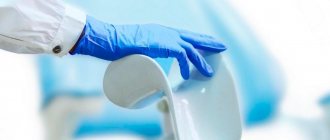- Treatment of hydrosalpinx
- Pregnancy and hydrosalpinx
- IVF for hydrosalpinx
- Prevention of hydrosalpinx
Hydrosalpinx (sactosalpinx) is the name given to transudate accumulated in the fallopian tube. The formation of transudate is not associated with inflammatory processes; it consists of secretions secreted by the fallopian tubes, extracellular fluid and blood plasma. Hydrosalpinx occurs as a result of an adhesive process in the fallopian tubes: due to a narrowing of the lumen of the tube (up to complete obstruction) and impaired blood circulation in its walls, transudate accumulates in some area.
There are simple (single closed cavity with fluid) and follicular (several cavities) hydrosalpinx. From time to time, it is possible for fluid to leak into the uterine cavity, or it can be absorbed into the walls of the tube, but the presence of adhesions contributes to the re-formation of hydrosalpinx in the same place, which causes a recurrent course of the disease.
When the cavity is filled with transudate, the walls of the pipe in this area are significantly stretched and thinned. The size of hydrosalpinx, as a rule, ranges from one to several centimeters, and it can have different, including irregular shapes.
Symptoms of hydrosalpinx
Clinical manifestations depend on how severe and how long the hydrosalpinx has existed. In some cases, symptoms may be completely absent, and pathology is detected by chance, for example, during a preventive ultrasound of the pelvic organs.
The main symptoms include pain in the lower abdomen, which is often nagging in nature. Typically, hydrosalpinx develops over a long period of time and when a sufficiently large amount of fluid accumulates, the patient complains of a feeling of heaviness in the groin area. In addition, there may be copious fluid discharge - this occurs if the hydrosalpinx empties. An increase in temperature to 38-39 degrees, throbbing pain, weakness, and in some cases tachycardia are characteristic of the acute form of the disease (against the background of acute salpingitis), when the formation of serous exudate (fluid arising at the site of inflammation) occurs in the cavity.
Are there any restrictions necessary for this disease?
Yes, definitely. Firstly, physical activity should be avoided (vibration, straining, sudden changes in body position: somersaults, bending, jumping). Secondly, avoid excessive activity during sexual intercourse, which increases pain. In addition, it is not recommended to sunbathe and visit a solarium, as well as visiting baths, saunas and taking hot baths, which can provoke an exacerbation of the inflammatory process.
It is undesirable to swim in the pool and open reservoirs, as local hypothermia will also provoke an exacerbation. It is prohibited to drink alcohol, including low-alcohol drinks, which suppresses the immune system.
Kinds
It is customary to distinguish several types of hydrosalpinx based on the composition of the accumulated fluid, location, severity of clinical symptoms, form of formation, as well as its morphology.
According to the composition of the liquid:
- hydrosalpinx (sactosalpinx) serous or simple;
- pyosalpinx (accumulation of pus);
- hematosalpinx (blood in the tube).
By location:
- right-sided hydrosalpinx;
- left-sided hydrosalpinx (much more common);
- double-sided
According to the form of the disease:
- spicy;
- chronic.
By form of education:
- oval;
- tubular;
- bell-shaped;
- irregular shape.
According to morphological structure:
- plain (one plain capsule);
- follicular (multiple formations with septa);
- valve (slight release of the contents of the hydrosalpinx with mucus).
Causes of hydrosalpinx
The development of hydrosalpinx (accumulation of fluid in the lumen of the fallopian tubes) is possible in women of different age categories, but most often the pathology is detected in patients during the reproductive period.
Among the causes of hydrosalpinx are:
- infectious processes;
- conditions after surgery and injury;
- endometriosis;
- development of tumor formations.
Let's look at some of them in more detail.
Infection
So, the first place in the development of hydrosalpinx is infection. Under the influence of pathogenic microorganisms, its epithelium is rejected and fibrosis develops.
The mucous membrane of the fallopian tube is represented by villous epithelium, without which it becomes impossible for the mature egg to move towards the active sperm, and therefore, conception.
Against the background of an inflammatory process caused by STI pathogens or nonspecific microflora, damage occurs to the villi of the epithelium lining the mucous membrane from the inside. Subsequently, pathological changes cover the entire thickness of the pipe. As a result, the organ becomes less elastic and deformed. In response to all these inflammatory changes, fibrin is produced. As a result, adhesions form and the patency of the pipe is impaired.
Tumors
The formation of a tumor on the fallopian tube and nearby organs can also cause a decrease in its lumen and fluid retention. Against the background of prolonged compression, circulatory disturbance occurs with subsequent degradation of the structure and the formation of adhesions inside the cavity of the pipe.
What factors cause salpingoophoritis?
Salpingo-oophoritis is possible in a woman if staphylococci, E. coli, streptococci, mycobacterium tuberculosis, gonococci and other pathogenic microorganisms penetrate into the fallopian tubes and then into the ovaries. Escherichia coli, as well as cocci, penetrate upward from the uterus, Mycobacterium tuberculosis enters from the lungs and other organs through the hematogenous route, through the bloodstream.
Salpingo-oophoritis can occur due to overwork, weakened immunity, or swimming in cool water. In each case of the disease, timely treatment is necessary.
Acute inflammation of the uterine appendages can be caused by a general infectious disease, as a result of weakened immunity. In this case, the pathogen enters the pelvis from an infected focus, which can be purulent tonsils or an inflamed maxillary sinus.
The infection can also be transmitted sexually, mainly due to a decrease in local immunity, after an abortion or other intrauterine interventions.
Often, acute salpingoophoritis or exacerbation of chronic salpingoophoritis is diagnosed if an abortion has been performed, since it represents a very strong stress for the female body. And exacerbation of existing chronic salpingoophoritis can be facilitated by hypothermia, stress, constant overwork, and lack of proper nutrition.
Treatment of hydrosalpinx
First of all, it is necessary to identify and eliminate the cause of the development of hydrosalpinx - as a rule, it is an inflammatory process (salpingitis, salpingoophoritis, adnexitis). However, existing adhesions cannot be eliminated with medication, which means hydrosalpinx will reappear. The only method to avoid relapse is surgical intervention, during which the patency of the pipes is restored by excision of adhesions located inside and around the pipe. However, there is no guarantee that after laparoscopy the tubes will function normally: stretching of the tube walls and the formation of connective tissue has worsened their contractile activity, and the cilia located on the mucosa have lost their mobility. As a result, the mature oocyte may not reach the uterus. Thus, the patient develops infertility and the risk of ectopic pregnancy increases. The feasibility of surgical treatment is assessed by a doctor based on an analysis of the pathological process, which includes an assessment of such parameters as the severity and density of adhesions, the condition of the mucous membrane and the thickness of the wall of the fallopian tube, and the diameter of the hydrosalpinx.
Diagnostics
Diagnosis of the disease we are considering is carried out in several stages. These include the following:
- Ultrasound. An ultrasound examination determines the presence of a fluid formation between the ovaries and the uterus.
- Gynecological examination. In this case, it is possible to identify between the ovary and the uterus a tightly elastic formation of an ovoid or round shape, which, as a rule, is painless or slightly painful.
- Laparoscopy. As in a number of other gynecological diseases, this method is not only diagnostic, but also therapeutic.
- Hysterosalpingography. The nature of the x-ray picture may be similar to the nature of fallopian tube obstruction. In the case of valve sactosalpinx, filling the tube with a contrast agent determines its external resemblance to a twisted “sausage”.
Pregnancy and hydrosalpinx
Women planning to become mothers, upon learning that they have hydrosalpinx, immediately wonder whether this pathology will affect conception.
With timely diagnosis and adequate treatment, complications and the development of infertility can usually be avoided.
How does pregnancy proceed with hydrosalpinx of one tube? This is perhaps the most common question that patients with this diagnosis ask the doctor. If the egg matures in the ovary on the healthy fallopian tube side, then there are no obstacles to fertilization. If the egg is released from the fallopian tube with hydrosalpinx, then the chances of successful conception are reduced.
The diagnosis of “hydrosalpinx” threatens not only the formation of serous fluid in the lumen of the fallopian tube, which can flow into the uterine cavity and disrupt the process of embryo implantation. If there is a mechanical obstruction in the path of the fertilized oocyte, an ectopic pregnancy may develop.
Pregnancy after removal of hydrosalpinx is possible, but only if the formation was small and the adhesive process was poorly developed.
The onset of pregnancy after surgery is affected by:
- the presence of single adhesions. In the case of follicular (multiple) adhesions, the fallopian tube is removed, and then the chances of conception are reduced;
- density of adhesions (the more elastic they are, the easier they are to remove);
- capsule size (if it is more than 2.5 centimeters, the chances of pregnancy are reduced or absent altogether);
- the condition of the mucous membrane of the fallopian tube (the more folds, the fewer fimbriae it contains);
- thickness of the wall of the fallopian tube (the thicker it is, the worse the peristalsis, which ultimately leads to a lack of mobility of the organ).
Structure and physiological functions of the fallopian tube
It is also called the oviduct. It is a hollow, with a lumen width of up to 1 mm, paired anatomical formation about 10-12 cm long, connecting the fundus of the uterus with the pelvic cavity. With one hole, the fallopian tube opens into the uterine cavity. Its distal end ends on the ovary and contains a second opening, bordered by fimbriae.
The walls of the fallopian tube consist of three membranes - serous, muscular and mucous. The serous membrane covers the outside of the oviduct, the muscular membrane consists of two differently directed layers of smooth muscle fibers, which provide the oviduct with peristalsis (contractions) in the direction from the ovaries to the uterus. The mucous membrane forms longitudinal folds and is a layer of cells of cylindrical ciliated epithelium with villi. Between the epithelial cells are glandular cells that secrete mucus into the lumen of the tube. This mucus ensures the constancy of the internal environment of the tube, helps maintain the activity of sperm, the viability of the egg and the embryo in the early stages of its formation.
During the period of ovulation, the egg is captured by the fimbriae and then, as a result of peristalsis and vibrations of the villi of the ciliated epithelium, moves into the uterine cavity. Mucus secreted by glandular cells also freely enters the uterine cavity.
So, the physiological functions of the fallopian tubes are:
- Capture of an egg through fimbriae at the moment of its release from the follicle into the abdominal cavity (ovulation).
- Ensuring the movement of the egg and delivery of sperm from the horn (corner) of the uterus to the egg.
- Ensuring the vital activity of germ cells, preparing them for fusion and creating conditions for fertilization.
- Movement of the embryo into the uterus through peristalsis and increased activity of the epithelial cilia.
- Ensuring the development of the embryo until the implantation of the fertilized egg in the uterus.
IVF for hydrosalpinx
Long-term studies have proven that the presence of hydrosalpinx significantly reduces the effectiveness of infertility treatment using IVF: the likelihood of intrauterine pregnancy is reduced by almost 2 times, and the risk of miscarriage increases sharply.
Factors contributing to a decrease in the effectiveness of the IVF program:
- increased frequency of ectopic (tubal) pregnancy;
- reduction in the frequency of embryo implantation. The fluid contained in the lumen of the hydrosalpinx contains many microorganisms, lymphocytes, and other agents that have a toxic effect on embryos. Moreover, the prostaglandins, leukotrienes, and proinflammatory cytokines contained in this fluid disrupt the function of the endometrium, interfering with its ability to implant. The liquid contained in the hydrosalpinx, even when diluted to 1% solution, gives a pronounced embryotoxic effect;
- in the presence of large-sized hydrosalpinx, a mechanical effect occurs on the choroid plexuses supplying the ovaries, resulting in an inadequate response of the ovaries to stimulation of superovulation - a poor response of the ovaries;
- The normal anatomy of the fallopian tube is disrupted - its wall thickens and the mucous membrane becomes smooth. As a result, the number of receptors for progesterone and estradiol decreases, which indirectly may cause implantation problems.
In the presence of hydrosalpinx, restoring the patency of the fallopian tube through corrective surgery (salpingostomy) has a short-lived effect and can lead to relapse of the disease. Salpingectomy (removal of the fallopian tube) increases the effectiveness of the IVF program from 10 to 30-35%.
Prevention of hydrosalpinx
To date, there are no specific methods and means to prevent pathology.
Doctors strongly recommend following certain rules and fulfilling requirements that will reduce the risk of developing hydrosalpinx:
- if any complaints appear, you should immediately visit a doctor for further examination and timely treatment of pathologies of the pelvic organs;
- regularly visit an obstetrician-gynecologist for a preventive examination;
- strictly observe the rules of personal hygiene, including during menstruation;
- avoid frequent changes of sexual partners, use barrier methods of contraception;
- to refuse from bad habits;
- treat pregnancy planning responsibly;
- Healthy food;
- to live an active lifestyle.
If a woman has bilateral hydrosalpinx, and the patency of the tubes is impaired, they must be removed. Pregnancy can be achieved using assisted reproductive technologies.
Clinical prognosis
In addition to oncological diseases that pose a direct threat to a woman’s life, the most severe pathologies of the fallopian tubes include hydrosalpinx, pyosalpinx and salpingitis. These diseases carry a high risk of developing difficult-to-treat forms of female infertility, and therefore the main efforts should be aimed at their prevention.
Other diseases of the fallopian tubes are successfully treated and have favorable clinical prognoses both in terms of recovery and in the matter of preserving the possibility of subsequent childbearing - of course, subject to timely seeking medical help.
Obstetrician-gynecologist of the highest category. Kosolapova Ekaterina Vitalievna









